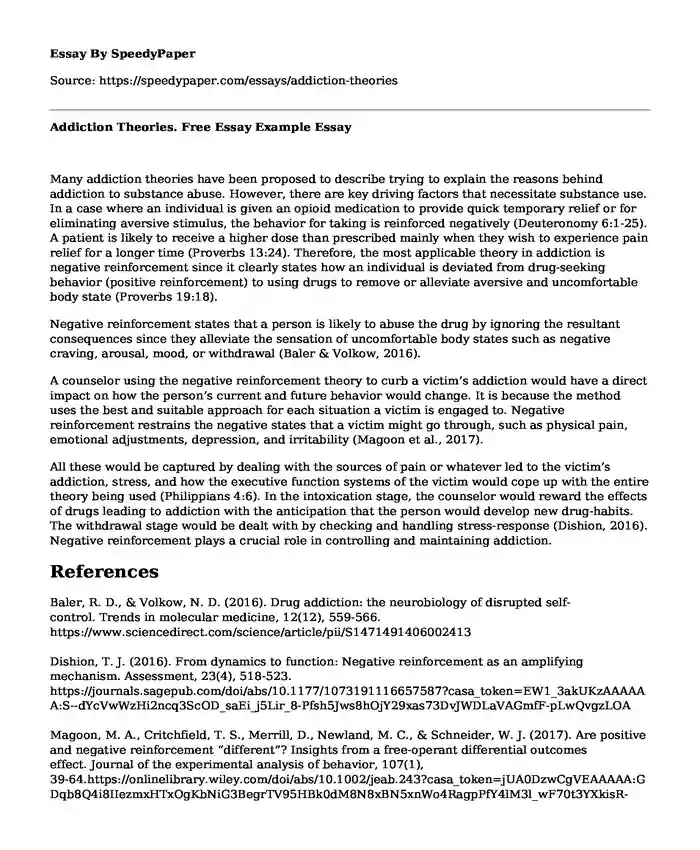
| Type of paper: | Essay |
| Categories: | Healthcare Drug abuse Behavior change |
| Pages: | 2 |
| Wordcount: | 391 words |
Many addiction theories have been proposed to describe trying to explain the reasons behind addiction to substance abuse. However, there are key driving factors that necessitate substance use. In a case where an individual is given an opioid medication to provide quick temporary relief or for eliminating aversive stimulus, the behavior for taking is reinforced negatively (Deuteronomy 6:1-25). A patient is likely to receive a higher dose than prescribed mainly when they wish to experience pain relief for a longer time (Proverbs 13:24). Therefore, the most applicable theory in addiction is negative reinforcement since it clearly states how an individual is deviated from drug-seeking behavior (positive reinforcement) to using drugs to remove or alleviate aversive and uncomfortable body state (Proverbs 19:18).
Negative reinforcement states that a person is likely to abuse the drug by ignoring the resultant consequences since they alleviate the sensation of uncomfortable body states such as negative craving, arousal, mood, or withdrawal (Baler & Volkow, 2016).
A counselor using the negative reinforcement theory to curb a victim’s addiction would have a direct impact on how the person’s current and future behavior would change. It is because the method uses the best and suitable approach for each situation a victim is engaged to. Negative reinforcement restrains the negative states that a victim might go through, such as physical pain, emotional adjustments, depression, and irritability (Magoon et al., 2017).
All these would be captured by dealing with the sources of pain or whatever led to the victim’s addiction, stress, and how the executive function systems of the victim would cope up with the entire theory being used (Philippians 4:6). In the intoxication stage, the counselor would reward the effects of drugs leading to addiction with the anticipation that the person would develop new drug-habits. The withdrawal stage would be dealt with by checking and handling stress-response (Dishion, 2016). Negative reinforcement plays a crucial role in controlling and maintaining addiction.
References
Baler, R. D., & Volkow, N. D. (2016). Drug addiction: the neurobiology of disrupted self-control. Trends in molecular medicine, 12(12), 559-566. https://www.sciencedirect.com/science/article/pii/S1471491406002413
Dishion, T. J. (2016). From dynamics to function: Negative reinforcement as an amplifying mechanism. Assessment, 23(4), 518-523. https://journals.sagepub.com/doi/abs/10.1177/1073191116657587?casa_token=EW1_3akUKzAAAAAA:S--dYcVwWzHi2ncq3ScOD_saEi_j5Lir_8-Pfsh5Jws8hOjY29xas73DvJWDLaVAGmfF-pLwQvgzLOA
Magoon, M. A., Critchfield, T. S., Merrill, D., Newland, M. C., & Schneider, W. J. (2017). Are positive and negative reinforcement “different”? Insights from a freeoperant differential outcomes effect. Journal of the experimental analysis of behavior, 107(1), 39-64.https://onlinelibrary.wiley.com/doi/abs/10.1002/jeab.243?casa_token=jUA0DzwCgVEAAAAA:GDqb8Q4i8IIezmxHTxOgKbNiG3BegrTV95HBk0dM8N8xBN5xnWo4RagpPfY4lM3l_wF70t3YXkisR-HB5g
Cite this page
Addiction Theories. Free Essay Example. (2023, Aug 06). Retrieved from https://speedypaper.com/essays/addiction-theories
Request Removal
If you are the original author of this essay and no longer wish to have it published on the SpeedyPaper website, please click below to request its removal:
- Research Proposal Paper Sample: Evaluation of Hypericin Herb-Drug Interactions
- Paper Sample: The American Healthcare Delivery System
- Essay Sample on Health Care Systems: Variations Across the Globe
- Free Essay: A Family-Centered Approach to Healthcare
- Essay Sample on Effective Ways to Motivate Employees Inside a Business Workspace
- Free Essay Example: Organizational Problem Analysis
- Victims Blaming in Chanel Millers Case
Popular categories




